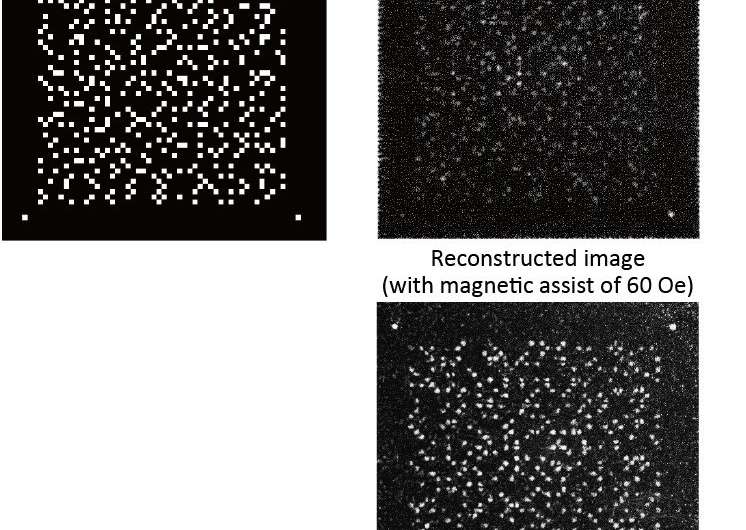Reconstructed image with and without magnetic assist. Credit: (C) Toyohashi University Of Technology.
In recent years, due to technology such as the Internet and 8K broadcasting, more information is being distributed across the world. Along with this trend, there is a demand for an innovative method for storing large volumes of data at ultra-high recording density and at ultra-high speed. Magnetic-holographic memory meets this demand. This new technology enables storing more than 1 TB of data on a disc the size of a DVD or Blu-ray. This is equivalent to the total capacity of 40 Blu-ray discs, each with a typical capacity of 25 GB
In magnetic hologram recording, a medium is magnetized in one direction; then the medium is irradiated with an information-bearing beam (signal beam) and a reference beam; the resulting interference pattern is recorded in the form of the difference in magnetization directions. When this process is conducted within an external magnetic field, the recording of the difference in magnetization directions becomes clearer. This is called magnetic assist recording.
The research group led by Yuichi Nakamura, Associate professor at Toyohashi University of Technology, has applied this magnetic assist recording technology to magnetic-holographic memory, and for the first time, the researchers have succeeded in reducing recording energy consumption and achieving non-error data reconstruction.
Through simulation, the group investigated the size of the stray magnetic field required for magnetization reversal in magnetic hologram recording. As a result, they found that the thinner the medium, the smaller the necessary stray magnetic field and the less clear the hologram recording. They also proved through experiments that magnetic assist recording yields a clear magnetic hologram even with a thin medium, and the magnetic hologram yields a bright reconstruction beam upon irradiation with a reference beam. Through further experiments, they found that magnetic assist recording and reconstruction of two-dimensional data yields clear reconstruction images. As a result of this research, the group has achieved a significant reduction in in data recording and reconstruction errors with a small amount of energy as well as non-error recording and reconstruction with magnetic-holographic memory.
"Until now, it has been difficult to obtain a clear reconstruction image with a magnetic hologram due to strict requirements for material characteristics, optical conditions, and so on. Using magnetic assist recording, we have relaxed these requirements and also improved the reconstruction performance of recording media. This technology is promising for the future application of magnetic-holographic memory," says first author Shirakashi.
They intend to improve recording density, and their goal is to apply this technology to make a portable, ultra-high-density, high-speed optical information storage medium outperforming Blu-ray discs and capable of storing high-volume contents from various sources including 8K Super Hi-Vision broadcasting and 3-D films, and to enable wide application of this technology in various types of storage systems, including archive and cold storage for storing information such as medical image data, SNS data on the Internet, and high-volume data in data centers.
More information: Zen Shirakashi et al, Reconstruction of non-error magnetic hologram data by magnetic assist recording, Scientific Reports (2017). DOI: 10.1038/s41598-017-12442-z
Journal information: Scientific Reports
Provided by Toyohashi University of Technology























